
(a)
Interpretation:
The hybridization of the central atom of the molecules with the following molecular geometries has to be predicted.
- (a) Tetrahedral (b) trigonal planar (c) trigonal bipyramidal (d) linear (e) octahedral
Concept Introduction:
Hybridization is a hypothetical concept. It refers to overlapping of atomic orbitals and the resultant orbitals formed are known as hybrid orbitals. An orbital that doesn’t involve in hybridization is termed as unhybridized orbital. After hybridization, the orbitals cannot be distinguished individually. The orientation of the orbitals while overlapping impacts the nature of the bond forms. By knowing the hybridization of central atom in the molecule its geometry can be predicted and vice-versa.
(a)
Answer to Problem 7.52QP
| Molecular Geometry | Hybridization of the central atom | |
| (a) | Tetrahedral |
|
Explanation of Solution
Tetrahedral
A molecule having tetrahedral geometry has the empirical formula
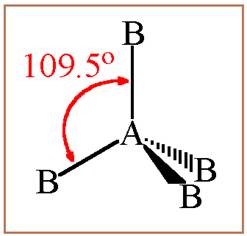
Figure 1
The bond angle between two atoms in a tetrahedral molecule is
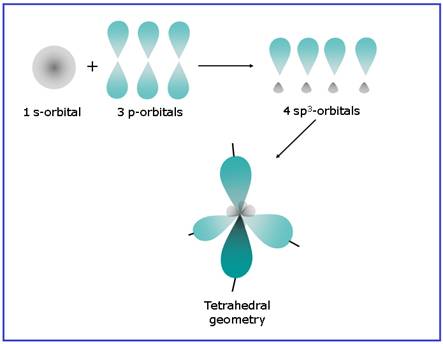
Figure 2
Thus a molecule having tetrahedral geometry has central atom with
(b)
Interpretation:
The hybridization of the central atom of the molecules with the following molecular geometries has to be predicted.
- (a) Tetrahedral (b) trigonal planar (c) trigonal bipyramidal (d) linear (e) octahedral
Concept Introduction:
Hybridization is a hypothetical concept. It refers to overlapping of atomic orbitals and the resultant orbitals formed are known as hybrid orbitals. An orbital that doesn’t involve in hybridization is termed as unhybridized orbital. After hybridization, the orbitals cannot be distinguished individually. The orientation of the orbitals while overlapping impacts the nature of the bond forms. By knowing the hybridization of central atom in the molecule its geometry can be predicted and vice-versa.
(b)
Answer to Problem 7.52QP
| Molecular Geometry | Hybridization of the central atom | |
| (b) | Trigonal planar |
|
Explanation of Solution
Trigonal planar
A molecule having trigonal planar geometry has the empirical formula
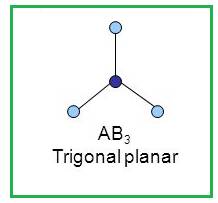
Figure 3
The bond angle between two atoms in a trigonal planar molecule is
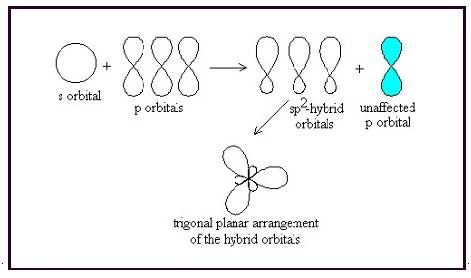
Figure 4
Thus a molecule having trigonal planar geometry has central atom with
(c)
Interpretation:
The hybridization of the central atom of the molecules with the following molecular geometries has to be predicted.
- (a) Tetrahedral (b) trigonal planar (c) trigonal bipyramidal (d) linear (e) octahedral
Concept Introduction:
Hybridization is a hypothetical concept. It refers to overlapping of atomic orbitals and the resultant orbitals formed are known as hybrid orbitals. An orbital that doesn’t involve in hybridization is termed as unhybridized orbital. After hybridization, the orbitals cannot be distinguished individually. The orientation of the orbitals while overlapping impacts the nature of the bond forms. By knowing the hybridization of central atom in the molecule its geometry can be predicted and vice-versa.
(c)
Answer to Problem 7.52QP
| S.No | Molecular Geometry | Hybridization of the central atom |
| (c) | Trigonal bipyramidal |
|
Explanation of Solution
Trigonal bipyramidal
A molecule having trigonal bipyramidal geometry has the empirical formula
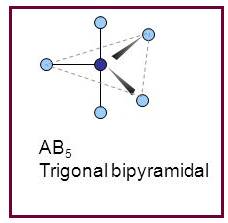
Figure 5
Trigonal bipyramidal molecule has two set of bonds – two axial bonds and three equatorial bonds. The two axial bonds are
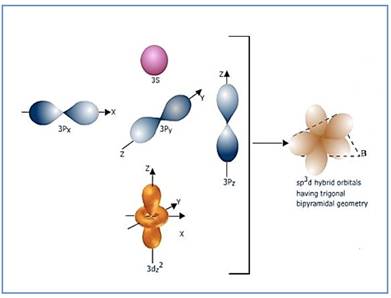
Figure 6
If the d-orbital of the
(d)
Interpretation:
The hybridization of the central atom of the molecules with the following molecular geometries has to be predicted.
- (a) Tetrahedral (b) trigonal planar (c) trigonal bipyramidal (d) linear (e) octahedral
Concept Introduction:
Hybridization is a hypothetical concept. It refers to overlapping of atomic orbitals and the resultant orbitals formed are known as hybrid orbitals. An orbital that doesn’t involve in hybridization is termed as unhybridized orbital. After hybridization, the orbitals cannot be distinguished individually. The orientation of the orbitals while overlapping impacts the nature of the bond forms. By knowing the hybridization of central atom in the molecule its geometry can be predicted and vice-versa.
(d)
Answer to Problem 7.52QP
| S.No | Molecular Geometry | Hybridization of the central atom |
| (d) | Linear |
|
Explanation of Solution
Linear
A molecule having linear geometry has the empirical formula
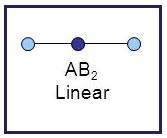
Figure 7
The bond angle between two atoms in linear molecule is
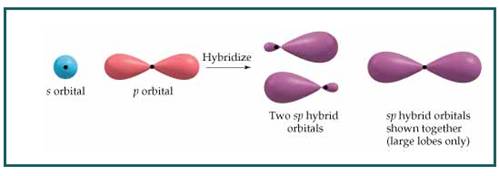
Figure 8
Thus a molecule having linear geometry has central atom with
(e)
Interpretation:
The hybridization of the central atom of the molecules with the following molecular geometries has to be predicted.
- (a) Tetrahedral (b) trigonal planar (c) trigonal bipyramidal (d) linear (e) octahedral
Concept Introduction:
Hybridization is a hypothetical concept. It refers to overlapping of atomic orbitals and the resultant orbitals formed are known as hybrid orbitals. An orbital that doesn’t involve in hybridization is termed as unhybridized orbital. After hybridization, the orbitals cannot be distinguished individually. The orientation of the orbitals while overlapping impacts the nature of the bond forms. By knowing the hybridization of central atom in the molecule its geometry can be predicted and vice-versa.
(e)
Answer to Problem 7.52QP
| S.No | Molecular Geometry | Hybridization of the central atom |
| (e) | Octahedral |
|
Explanation of Solution
Octahedral
A molecule having octahedral geometry has the empirical formula
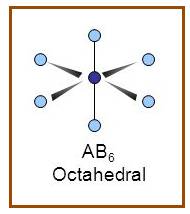
Figure 9
The bond angle between two atoms in octahedral molecule is
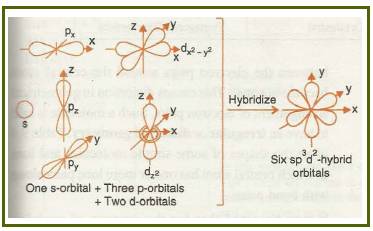
Figure 10
If the d-orbital of the
The hybridization of the central atom of the molecules with the given molecular geometries has been predicted.
Want to see more full solutions like this?
Chapter 7 Solutions
CHEMISTRY:ATOMS FIRST-2 YEAR CONNECT
- Show how to convert ethyl benzene to (a) 2,5-dichlorobenzoic acid and (b) 2,4-dichlorobenzoic acid.arrow_forwardHelp me solve this problem. Thank you in advance.arrow_forward22.7 Predict the monoalkylated products of the following reactions with benzene. (a) AlCl3 Ya (b) AlCl3 (c) H3PO4 (d) 22.8 Think-Pair-Share AICI3 The reaction below is a common electrophilic aromatic substitution. SO3 H₂SO4 SO₂H (a) Draw the reaction mechanism for this reaction using HSO,+ as the electrophile. (b) Sketch the reaction coordinate diagram, where the product is lower in energy than the starting reactant. (c) Which step in the reaction mechanism is highest in energy? Explain. (d) Which of the following reaction conditions could be used in an electrophilic aro- matic substitution with benzene to provide substituted phenyl derivatives? (i) AICI3 HNO3 H₂SO4 K2Cr2O7 (iii) H₂SO4 (iv) H₂PO₁arrow_forward
- Is an acid-base reaction the only type of reaction that would cause leavening products to rise?arrow_forwardHelp me understand this! Thank you in advance.arrow_forward22.22 For each compound, indicate which group on the ring is more strongly activating and then draw a structural formula of the major product formed by nitration of the compound. Br CHO (a) CH3 (b) (c) CHO CH3 SO₂H (d) ☑ OCHS NO₂ (e) (f) CO₂H NHCOCH3 NHCOCH, (h) CHS 22.23 The following molecules each contain two aromatic rings. (b) 000-100- H3C (a) (c) Which ring in each undergoes electrophilic aromatic substitution more readily? Draw the major product formed on nitration.arrow_forward
- V Consider this step in a radical reaction: Br: ? What type of step is this? Check all that apply. Draw the products of the step on the right-hand side of the drawing area below. If more than one set of products is possible, draw any set. Also, draw the mechanism arrows on the left-hand side of the drawing area to show how this happens. ⚫ionization termination initialization neutralization none of the abc Explanation Check 80 Ο F3 F1 F2 2 F4 01 % do5 $ 94 #3 X 5 C MacBook Air 25 F5 F6 66 ©2025 ˇ F7 29 & 7 8arrow_forwardShow how to convert ethyl benzene to (a) 2,5-dichlorobenzoic acid and (b) 2,4-dichlorobenzoic acid.arrow_forwardno aiarrow_forward
- Polymers may be composed of thousands of monomers. Draw three repeat units (trimer) of the polymer formed in this reaction. Assume there are hydrogen atoms there are hydrogen atoms on the two ends of the trimer. Ignore inorganic byproducts.arrow_forwardDraw a tetramer if this alternating copolymer pleasearrow_forwardDraw the monomers required to synthesize this condensation polymer.arrow_forward
 Chemistry: Principles and PracticeChemistryISBN:9780534420123Author:Daniel L. Reger, Scott R. Goode, David W. Ball, Edward MercerPublisher:Cengage Learning
Chemistry: Principles and PracticeChemistryISBN:9780534420123Author:Daniel L. Reger, Scott R. Goode, David W. Ball, Edward MercerPublisher:Cengage Learning Chemistry: Principles and ReactionsChemistryISBN:9781305079373Author:William L. Masterton, Cecile N. HurleyPublisher:Cengage Learning
Chemistry: Principles and ReactionsChemistryISBN:9781305079373Author:William L. Masterton, Cecile N. HurleyPublisher:Cengage Learning Chemistry: The Molecular ScienceChemistryISBN:9781285199047Author:John W. Moore, Conrad L. StanitskiPublisher:Cengage Learning
Chemistry: The Molecular ScienceChemistryISBN:9781285199047Author:John W. Moore, Conrad L. StanitskiPublisher:Cengage Learning Chemistry & Chemical ReactivityChemistryISBN:9781337399074Author:John C. Kotz, Paul M. Treichel, John Townsend, David TreichelPublisher:Cengage Learning
Chemistry & Chemical ReactivityChemistryISBN:9781337399074Author:John C. Kotz, Paul M. Treichel, John Townsend, David TreichelPublisher:Cengage Learning Chemistry & Chemical ReactivityChemistryISBN:9781133949640Author:John C. Kotz, Paul M. Treichel, John Townsend, David TreichelPublisher:Cengage LearningChemistry: Matter and ChangeChemistryISBN:9780078746376Author:Dinah Zike, Laurel Dingrando, Nicholas Hainen, Cheryl WistromPublisher:Glencoe/McGraw-Hill School Pub Co
Chemistry & Chemical ReactivityChemistryISBN:9781133949640Author:John C. Kotz, Paul M. Treichel, John Townsend, David TreichelPublisher:Cengage LearningChemistry: Matter and ChangeChemistryISBN:9780078746376Author:Dinah Zike, Laurel Dingrando, Nicholas Hainen, Cheryl WistromPublisher:Glencoe/McGraw-Hill School Pub Co





